Related Research Articles

The Country Music Hall of Fame and Museum in Nashville, Tennessee, is one of the world's largest museums and research centers dedicated to the preservation and interpretation of American vernacular music. Chartered in 1964, the museum has amassed one of the world's most extensive musical collections.
The Nashville sound is a subgenre of American country music that originated in the 1950s in Nashville, Tennessee. It replaced the dominance of the rough honky tonk music with "smooth strings and choruses", "sophisticated background vocals" and "smooth tempos" associated with traditional pop. It was an attempt "to revive country sales, which had been devastated by the rise of rock 'n' roll".

Curb Records is an American record label started by Mike Curb, originally as Sidewalk Records in 1963. From 1969 to 1973, Curb merged with MGM Records where Curb served as President of MGM and Verve Records.

"Crazy" is a song written by Willie Nelson and popularized by country singer Patsy Cline in 1961. Nelson wrote the song while living in Houston, working for Pappy Daily's label D Records. He was also a radio DJ and performed in clubs. Nelson then moved to Nashville, Tennessee, working as a writer for Pamper Music. Through Hank Cochran, the song reached Patsy Cline. After her original recording and release, Cline's version reached number two on Billboard's Hot Country Singles, also crossing to the pop chart as a top 10 single.

Charlie McCoy, is an American harmonica virtuoso and multi-instrumentalist in country music. He is best known for his harmonica solos on iconic recordings such as Candy Man, He Stopped Loving Her Today, I Was Country When Country Wasn't Cool, and others. He was a member of the progressive country rock bands Area Code 615 and Barefoot Jerry. After recording with Bob Dylan in New York, McCoy is credited for unknowingly influencing Dylan to decide to come to Nashville to record the critically acclaimed 1966 album "Blonde on Blonde".

Music Row is a historic district located southwest of downtown Nashville, Tennessee, United States. Widely considered the heart of Nashville's entertainment industry, Music Row has also become a metonymous nickname for the music industry as a whole, particularly in country music, gospel music, and contemporary Christian music.

RCA Studio B was a music recording studio built in 1956 in Nashville, Tennessee by RCA Victor. Originally known simply as "RCA Studios," Studio B, along with the larger and later RCA Studio A became known in the 1960s for being an essential factor to the development of the musical production style and sound engineering technique known as the Nashville Sound. In the two decades the studio was in operation, RCA Studio B produced 60 percent of the Billboard magazine's Country chart hits. The studio closed in 1977.
William Owen Bradley was an American musician, bandleader and record producer who, along with Chet Atkins, Bob Ferguson, Bill Porter, and Don Law, was a chief architect of the 1950s and 60s Nashville sound in country music and rockabilly.
Harold Ray Bradley was an American guitarist and entrepreneur, who played on many country, rock and pop recordings and produced numerous TV variety shows and movie soundtracks. Having started as a session musician in the 1940s, he was a part of the Nashville A-Team of session players, which included pianist Floyd Cramer and pedal steel guitarist Pete Drake. He is one of the most recorded guitarists in music history.

Songs from My Heart.... is a studio album by American country singer-songwriter Loretta Lynn. It was released on February 15, 1965 via Decca Records and was produced by Owen Bradley. It was Lynn's third studio album released in her career and contained a total of 12 tracks. The album charted on the Billboard albums chart following its release and contained one single. The song, "Happy Birthday" became a major hit on the Billboard country chart in 1965.

You Ain't Woman Enough is the seventh solo studio album by American country music singer-songwriter Loretta Lynn. It was released on September 12, 1966, by Decca Records. It was Lynn's first No. 1 album on the US Billboard Hot Country Albums chart, as well as her first album to chart on the Billboard Top LPs chart.
James Harold Shedd is an American music industry executive and record producer best known for his role as producer of the country group Alabama as well as Reba McEntire, Shania Twain and Toby Keith. During his career he has headed Mercury Records and Mercury's sister label, Polydor.
"Don't Worry" is a song written and recorded by American country music artist Marty Robbins. It was released in February 1961 as the third single from his compilation album More Greatest Hits. The song was Robbins' seventh number one on the country chart and stayed at number one for ten weeks. The single crossed over to the pop chart and was one of Marty Robbins' most successful crossover songs, peaking at number three on the Hot 100.
Mark Wright is an American record producer who works mainly in country music. He is known for having worked with Brooks & Dunn, Gary Allan, and Lee Ann Womack.

Donald Firth Law was an English-American record producer and music business executive. He produced Robert Johnson's only recordings, and as head of Columbia Records' country music division later worked with many leading country musicians including Bob Wills, Carl Smith, Flatt and Scruggs, Lefty Frizzell, Ray Price, Johnny Horton, Marty Robbins and Johnny Cash.
Paul William Leim is an American drummer and recording session musician based in Nashville.

RCA Studio A is a music recording studio in Nashville, Tennessee built and founded in 1964 by Chet Atkins, Owen Bradley and Harold Bradley. Originally known simply by the name "RCA Victor Nashville Sound Studios", along with the adjacent RCA Studio B, it became known in the 1960s for becoming an essential factor and location to the development of the musical production style and sound engineering technique known as the Nashville Sound.

Showcase is a studio album by American country singer-songwriter Bill Anderson. It was released in November 1964 on Decca Records and was produced by Owen Bradley. The album was Anderson's third studio release as a recording artist and second to be released in 1964. It included two singles that became major hits on the Billboard country chart along with subsequent B-sides.
Jerry Owen Bradley was an American music executive known for his role in country music. As head of RCA Records in Nashville from 1973 to 1982, Bradley was involved in the marketing and creation of the first platinum album in country music, Wanted! The Outlaws, which reached that mark in 1976. Bradley was inducted in the Country Music Hall of Fame in 2019.

Bradley's Barn was a music recording studio founded in the mid-1960s by Owen Bradley. The studio was built in a converted barn on farmland in the Nashville suburb of Mount Juliet, and was the site of numerous notable recordings by artists including Loretta Lynn, Conway Twitty, The Beau Brummels, J. J. Cale, Bill Anderson, k.d. lang, George Jones and others.
References
- 1 2 3 Kosser, Michael (2006). How Nashville Became Music City, U.S.A.: 50 Years of Music Row . Hal Leonard. p. 12. ISBN 9780634098062.
- 1 2 Hoobler, James A. (2008). A Guide to Historic Nashville, Tennessee. The History Press. p. 105. ISBN 9781596294042.
- 1 2 Roy, James V. (April 2004). "RCA Victor Studio B Nashville". ScottyMoore.Net. Archived from the original on February 7, 2013. Retrieved January 31, 2013.
- ↑ Kosser, Michael (2006). How Nashville Became Music City, U.S.A.: 50 Years of Music Row . Hal Leonard. p. 11. ISBN 9780634098062.
- 1 2 Sanders, Daryl (2020). That Thin, Wild Mercury Sound: Dylan, Nashville, and the Making of Blonde on Blonde (epub ed.). Chicago: Chicago Review Press. pp. 99–100. ISBN 978-1-61373-550-3.
- ↑ "Nashville Skyline: New Life for the Quonset Hut". Mixonline.com. 2009-11-01. Archived from the original on 2013-03-04. Retrieved 2013-02-01.
- 1 2 Skates, Sarah (June 30, 2011). "Quonset Hut Hosts Reunion Celebration". Music Row. Archived from the original on September 4, 2011. Retrieved February 1, 2013.
- ↑ Chenoweth, Paul (May 19, 2014). "Historic Columbia Studio A Reopens as Educational Space for Belmont Students". Belmont. Archived from the original on November 27, 2022. Retrieved January 19, 2023.
- ↑ Fox, Randy (March 20, 2012). "Back at the Quonset Hut". WPLN/Nashville Public Radio. Archived from the original on May 19, 2012. Retrieved January 31, 2013.